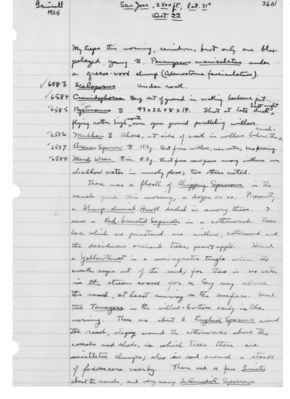Pages That Mention Mudhen
1925: Joseph Grinnell's field notes
S3 Page 58
S3 Page 58
Collector: Grinnell - 1925 Location: San Jose, 2500 ft., lat. 31° Date: Oct. 22 Page Number: 2601
My traps this morning, rained on, brot only one blue pelaged, young (male sign), Peromyscus manipulatus under a grease-wood clump (Adenostoma fasciculatum).
6583 Sceloporus Under rock. 6584 Cnemidophorus Dug out of ground in making barbecue pit. 6585 Nyctinomus (male sign) 93 x 32 x 8 x 14. Shot at late last dusk last night flying rather high north over open ground paralleling willows. 6586 Mudhen (female sign) alone, at side of creek in willow bellow the ranch. 6587 Brewer Sparrow (male sign) 11.9g. Shot from willow, near water; was preening. 6588 Marsh Wren (male sign) im. 11.9g. Shot from sawgrass among willows near shallow water in marshy place; two others noted.
There was a flock of Chipping Sparrows in the ranch yard this morning, a dozen or so. Presently a Sharp-shinned Hawk dashed in among them. I saw a Red-breasted Sapsucker in a cottonwood. Trees here which are punctured one willow, cottonwood and the deciduous orchard trees, pear & apple. Heard a Yellowthroat in a semi-aquatic tangle where the creek seeps out of the sand; for there is no water in the stream course for a long way above the ranch, at least running on the surface. Heard two Tanagers in the willow-bottom early in the morning. There are about 6 English Sparrows around the ranch, staying around the cottonwoods above the corrals and sheds, in which trees there are mistletoe clumps; also in and around a stock of fodder corn nearby. There are a few Linnets about the ranch, and very many Intermediate Sparrows.
S3 Page 68
Collector: Grinnell - 1925 Location: Colnett, Sat. 31 degrees Date: October 29, 1925 Page Number: 2610
6647 Dipodomys (male sign) 60.3g. 250 x 141 x 42 x 9. On silt-soil bottom. 6648 Thomomys (female sign) 96g. 207 x 70 x 26 x 4. “ “ “ 6649 Bewick Wren (female sign) ad. 9.9g. Shot from black-sage bush. 6650 Brown Towhee (male sign) ad. 44.5g “ “ lycium bush. 6651 “ “ (female sign) ad. 41.6g. Shot in flight among agaves. 6652 Horned Owl (female sign) bill, skull and a mass of feathers of Mudhen in stomach; flushed from willows out in valley where, at freshet time, the San Rafael River flows; now only sand there; but tidal seepage lagoons below, toward beach.
Drizzled during the night and this morning, but cleared up about 10 o’clock and now (2 p.m.) warm and sunshiny. Out early and then 7:30 to 9:30. Saw numerous Audubon Warblers around sumachs (R. laurina). Noted one Sparrow Hawk up on hillside among agave stems. These (old stalks) afford roosting places for many birds: Shrikes Ravens, Linnets, and today I saw an adult Red-Tailed Hawk perched on one. The new flower stalks are just shooting up, but not out yet. Saw a very white Marsh Hawk (probably same one) several times skimming above the bush tops on the bottomland. The coastal part of our “section” presents seeming contradictions: the air is humid a large part of the time, yet the vegetation is xerophilous in the extreme. The actual rainfall must be little, and there must be streaks of excessively dry weather. Here are eight species of cactus, the agave, 3 species of lycium,

